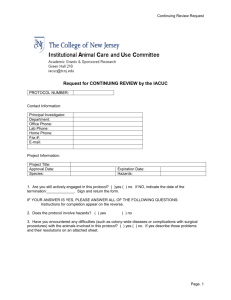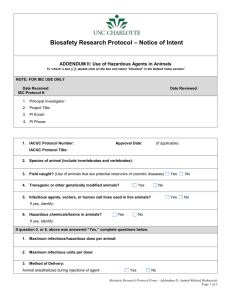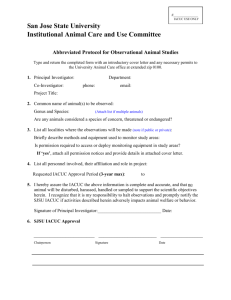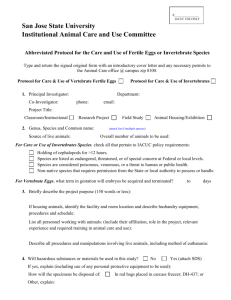Washington State University - Institutional Animal Care and
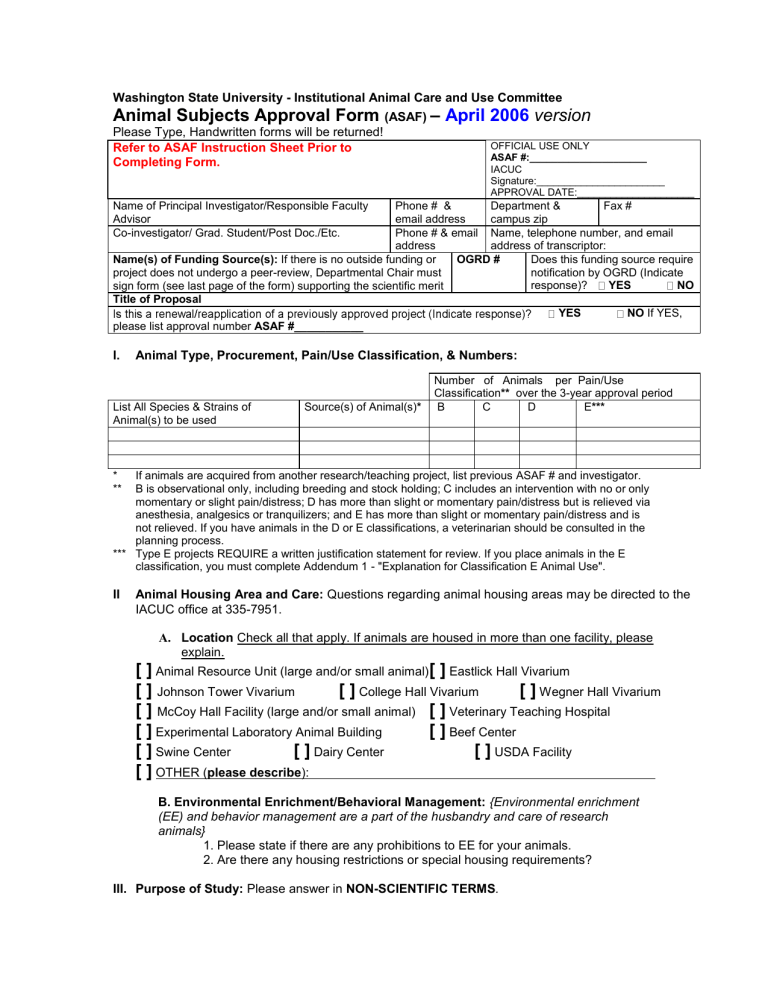
Washington State University - Institutional Animal Care and Use Committee
Animal Subjects Approval Form
(ASAF)
–
April 2006
version
Please Type, Handwritten forms will be returned!
Refer to ASAF Instruction Sheet Prior to
Completing Form.
Name of Principal Investigator/Responsible Faculty
Advisor
Co-investigator/ Grad. Student/Post Doc./Etc.
OFFICIAL USE ONLY
ASAF #:_____________________
IACUC
Signature:_______________________
APPROVAL DATE:_____________________
Department & campus zip
Fax #
Name(s) of Funding Source(s):
Phone # & email address
Phone # & email address
If there is no outside funding or project does not undergo a peer-review, Departmental Chair must sign form (see last page of the form) supporting the scientific merit
Title of Proposal
Name, telephone number, and email address of transcriptor:
OGRD # Does this funding source require notification by OGRD (Indicate response)? YES NO
YES NO If YES, please list approval number ASAF #___________
I. Animal Type, Procurement, Pain/Use Classification, & Numbers:
Number of Animals per Pain/Use
Classification ** over the 3-year approval period
Source(s) of Animal(s) * B C D E *** List All Species & Strains of
Animal(s) to be used
* If animals are acquired from another research/teaching project, list previous ASAF # and investigator.
** B is observational only, including breeding and stock holding; C includes an intervention with no or only momentary or slight pain/distress; D has more than slight or momentary pain/distress but is relieved via anesthesia, analgesics or tranquilizers; and E has more than slight or momentary pain/distress and is not relieved. If you have animals in the D or E classifications, a veterinarian should be consulted in the planning process.
*** Type E projects REQUIRE a written justification statement for review. If you place animals in the E classification, you must complete Addendum 1 - "Explanation for Classification E Animal Use".
II Animal Housing Area and Care: Questions regarding animal housing areas may be directed to the
IACUC office at 335-7951.
A.
Location Check all that apply. If animals are housed in more than one facility, please explain.
[ ]
Animal Resource Unit (large and/or small animal)
[ ]
Eastlick Hall Vivarium
[ ]
Johnson Tower Vivarium
[ ]
College Hall Vivarium
[ ]
Wegner Hall Vivarium
[ ]
McCoy Hall Facility (large and/or small animal)
[ ]
Veterinary Teaching Hospital
[ ]
Experimental Laboratory Animal Building
[ ]
Swine Center
[ ]
Dairy Center
[ ]
Beef Center
[ ]
USDA Facility
[ ]
OTHER ( please describe ):
B. Environmental Enrichment/Behavioral Management: {Environmental enrichment
(EE) and behavior management are a part of the husbandry and care of research
animals}
1. Please state if there are any prohibitions to EE for your animals.
2. Are there any housing restrictions or special housing requirements?
III. Purpose of Study: Please answer in NON-SCIENTIFIC TERMS.
A). Explain the specific objective(s) of your project/class and why the study is important to human or animal health, the advancement of knowledge, or the good of society.
B). Rationale for Animal Use:
1.
Why must animals be used? Why not cell cultures, computer models, etc.?
2.
Describe the biological characteristics of the animal species selected that justifies its use.
3. Justify animal numbers. How did you determine the number of animals required per group and the number of groups (e.g. dose groups, different compound groups, etc.). Show your calculations used to arrive at the total number requested for the study period (consistent with the chart in " I " of front page). For research, statistical justification is usually required. For instruction, start with students per animal from which to determine the total numbers requested. A table, flow chart or specific calculation showing group sizes, time frame, etc. is beneficial in assisting the reviewer(s) in determining exactly how many animals you plan to utilize.
C). Experimental Design (if research):
1. Describe the design of your experiment(s) to make clear the nature of the treatments the animals will receive even if this repeats other sections.
2. Start by identifying the source of animals, describe treatments, and conclude with final disposition of animals.
D). Animals for Instruction (if teaching) :
1. Start by identifying the source of the animals, describe the way the animals will be treated in the course, and conclude with final disposition of animals.
2. Discuss how students are trained to work with animals as required under the
Animal Welfare Act as appropriate for the course.
3. A statement of student notification is recommended for the course syllabus. For policy and suggestion see: http://www.iacuc.wsu.edu/handbook.asp
IV. Alternatives to Procedures causing Pain and/or Distress: If any procedure falls into the Animal
Use/Pain Classification D or E , causing more than momentary or slight pain or distress to animals (even if relieved), describe your consideration of alternative methods to the painful/distressful procedure(s). When literature searches are used, please complete the table below:
Database(s) Used
Date of Search
Years Searched
Keywords Used
If alternative methods to painful/distressful procedures were identified, why can't they be utilized in your project/class?
V. Animal Use Procedures Checklist: Respond to all items. For all YES responses, provide specifics in the narrative section., See section X. Some procedures require you to complete an additional form/addendum and must be included with your ASAF. Please refer to the ASAF Instruction Form Sheet for details on what is required for each procedure,
Please describe your expertise with each technique/procedure.
YES NO Ref.
No.
1
ANIMAL USE PROCEDURE
Breeding Protocol (animals being bred for use in protocols)
2
3
4
5
6
Stock Animal Protocol (animals being held for future assignment to protocols)
Blood Sampling
Other Bodily Fluid and Tissue Sampling in Live Animals
Tissue Harvesting (tissue collection after euthanasia)
Antibody Production
7
8
Administration of Paralytic Agents
Administration of Anesthetics, Analgesics or Tranquilizers (Note - If this is part of your surgical protocol, check "YES" and please describe in Addendum 3)
Administration of Infectious Organism (Infectious to either humans or animals; If 9 organism is infectious to humans you MUST also check YES to ref. no. 12 below and complete addendum 2)
10 Use of Ether (If YES, Complete Addendum 2)--justification required, refer to ASAF instructions.
11 Administration of Drugs/Reagents/Cells/ Etc. (other than paralytic agents, anesthetics, analgesics, or tranquilizers)
12 Hazardous Species/Radioactive Materials/Zoonotic Agents/Recombinant
DNA/Chemicals (If YES, Complete Addendum 2)
13 Special Diets
14 Food and/or Water Deprivation (Note - If only food is being withheld over night as part of pre-surgical care, you do not need to check "YES" here. Please describe this withholding period on Addendum 3 - "Animal Surgery Information Form")
15 Indwelling Catheters and/or Implants (If procedure involves surgery, Complete
Addendum 3)
16 Prolonged (>15 minutes) Physical Restraint (includes undersized caging such as metabolic units, animals which are "tethered" with leash or catheter, animals held in stocks/restraint devises, etc.)
17 Use/Handling of Wild/Non-Domesticated Animals (If YES, Complete Addendum 2 -
"Hazardous Species/Radioactive Materials/Zoonotic Agents/Recombinant
DNA/Chemicals Form")
18 Trapping of Animals
19 Field Study
20 Behavioral Testing (with or without prolonged restraint and/or noxious stimuli)
21 Tumor Production or Tumor Cell Transplantation
22 Transportation of Animals
ANIMAL SURGERY (Check which type of surgery classification will be performed and complete Addendum 3 - "Animal Surgery Information Form")
23 Non-Survival Surgery (any species) (Animal is not recovered and is euthanatized while under general anesthesia)
24
25
26
27
Single RODENT Survival Surgery
Single NON-RODENT Survival Surgery
Multiple Survival Surgery on an Individual Animal (any species)
Painful/Distressful Procedures Without the Use of Anesthetics, Analgesics or
Tranquilizers (If YES, animals must be placed in the Type E pain/use category in the table in Section I and you must complete Addendum 1)
28 Death as an Endpoint (Observing or studying an animal until natural death occurs; If
YES, animals must be placed in the Type E pain/use category in the table in Section I and you must complete Addendum 1)
29 Other Procedures Not Listed Above
VI. Study Areas:
A) Will animals be taken to a laboratory/study area outside the animal housing facility?
[ ]
YES
[ ]
NO
1. If YES, list building name and room number
2. What procedures will be performed in this area?
B) Will animals be taken to this area and maintained for longer than 12 hours ?
[ ]
YES
[ ]
NO
1.
If YES, What is the total length of time animals are maintained in this area?
2. Why must animals be maintained in this area rather than returned to the animal facility?
VII. Veterinary Care: Provider of medical care to your animals: {emergencies, illness, preventive medicine}
VIII. Method of Euthanasia:
IX. If Animals Are Not Euthanatized, Indicate Their Disposition (e.g. transferred to another project/class [indicate new project (ASAF) number and investigator]; sold at public sale/auction; private adoption; OTHER, please describe)
X. Narrative Section: Any item checked YES in Section V (Animal Use Procedures
Checklist), needs to be addressed here, except for procedures that require the completion of an addendum (i.e. type E procedures, hazards or surgery). Please refer to the ASAF Instruction Sheet for specific items to be addressed.
List procedures by
Reference Number (Ref. No.) listed in the section V.
XI. Personnel Qualifications:
List all personnel actively involved with animal components of the project and qualifications (as a minimum, should include principal investigator, co-investigator, research technicians, TA, graduate students, etc.).
Describe an individual's experience/training in all relevant animal related procedures. Indicate most recent date these individuals have attended an animal use seminar conducted by the Institutional Animal Care & Use
Committee (IACUC)* AND register in the WSU Animal Contact Program. Attach additional pages if necessary for completeness.
Individual:
Degree(s):
Brief outline of experience:
Role(s) on project:
Date attended an IACUC animal use seminar/class:
Individual:
Degree(s):
Brief outline of experience:
Individual:
Degree(s):
Role(s) on project:
Date attended an IACUC animal use seminar/class:
Role(s) on project:
Date attended an IACUC animal use seminar/class:
Brief outline of experience:
* You may contact the IACUC Office at (509) 335-7951 or Office of the Campus Vet at (509)335-8043 to inquire if an individual has attended an IACUC animal use seminar/class and to inquire on dates for future sessions.
===================================================================================
===
Investigators Assurance
The information contained on this form provides an accurate description of my animal care and use protocol.
All people using animals under my direction will be trained to use appropriate methods, and will have read and agree to comply with this protocol and with all regulations and policies concerning the use of animals, prior to commencing animal work associated with this protocol.
Discomfort of animals will be limited to that which is unavoidable. Analgesic, anesthetic, and tranquilizing drugs will be used where indicated and appropriate to minimize pain and discomfort. Except as specifically described in this protocol, veterinary care will be provided to animals showing evidence of pain and discomfort.
If animal uses or procedures described in this protocol should need to be revised or amended, I will notify the IACUC and gain IACUC approval for the modifications PRIOR to implementation. I understand that my failure to report significant changes may place the University and myself in violation of regulations and may result in suspension of my animal activities.
I will notify the IACUC regarding ANY unexpected results that adversely impact the animals in this protocol. Any unanticipated pain or distress, morbidity or mortality will be reported to the Attending Veterinarian (or designee) and the
IACUC.
I understand that the approval of this ASAF in no way obligates the IACUC or the
University to guarantee animal housing space, animals and/or equipment used to conduct the project.
As required by regulations, I assure that the activities described herein do not unnecessarily duplicate previous procedures/projects.
If the protocol is funded by a grant, I assure all procedures described in this protocol are covered by the grant.
I have read & agree with each of these statements: _________________________
Endorsement of Departmental Chair : As this teaching, testing and/or research project will be supported by departmental/internal/personal or non-peer reviewed funds, I endorse the above assurance and certify that I have reviewed this protocol description and it is judged to be of scientific merit.
Signature of Departmental Chair Date
ASAF #
Title:
Principal Investigator:
WSU-IACUC Animal Subjects Approval Form - September 2001 version
ADDENDUM 1
EXPLANATON FOR CLASSIFICATION E ANIMAL USE
(This document is required to accompany USDA Form 7023 - "Annual Report for Research
Facilities" to support any USDA animal use in the Classification E.)
Species of animal(s) in Classification E (if there is more then one species, please list all) :
For all animal use that falls within Classification E, please provide the following:
B.
A complete description of the procedure(s) producing pain and/or distress in the animal(s).
This explanation should include, as appropriate, the name of the test, the reference from the
Code of Federal Regulations if the test is mandated by federal regulations, or other relevant guidelines.
3.
A complete explanation for withholding drugs for relieving pain and/or distress. For example, provide scientific justification that such drugs would adversely affect the test/study results, or cite all regulation(s) and/or Federal Agency policies that prohibit the use of these drugs.
Signature of Principal Investigator:
Official Use Only
Approved by IACUC on:
Date:
USDA Covered Animal (check one):
YES NO
This addendum is to be included with your WSU-IACUC Animal Subjects Approval form or
Amendment
ASAF #
Title:
Principal Investigator:
WSU-IACUC Animal Subjects Approval Form - September 2001 version
ADDENDUM 2 - HAZARDOUS SPECIES/ RADIOACTIVE MATERIALS/ ZOONOTIC
AGENTS/RECOMBINANT DNA / CHEMICALS
Check and complete each section that is applicable to your project/class.
Please note that all individuals involved in a project/class resulting in exposure to any hazardous species/chemicals/zoonotic agents/ radioactive materials/etc. must be informed of the potential hazard(s) AND be provided training to reduce the hazard exposure/risk. This not only includes research/teaching personnel but also animal care staff and students . As the IACUC is not in charge of setting safety policies and procedures regarding the handling of hazardous species/chemicals/zoonotic agents/ radioactive materials/etc, it cannot advise you on the adequacy of the handling precautions you describe on your Animal Subjects Approval Form regarding the use of such hazards. Several WSU organizations govern and provide guidance regarding hazard use and personnel health and safety. Please consult with the organizations listed in each section if questions arise and/or approval is needed. All personnel should also have access to and be knowledgeable of the
WSU Safety Policies and Procedures Manual as this document contains information on waste disposal, occupational health & safety, biological and chemical policies, etc. Anyone can view this document on-line at: http://www.wsu.edu/~forms/manuals.html
.
[]
Section A). Use/handling of wild-caught/non-domesticated species: If you will be using/handling these types of animals, please complete this section. If you are planning on working with certain species of wild rodents, you must be knowledgeable of the WSU policy "
Guidelines for Handling Animal Reservoirs of Hantavirus". Any deviation from these guideline will require approval by the Institutional Biosafety Committee and the IACUC. If more than one wild-caught/non-domesticated species is involved in this project/class, please address each part of this section for all species.
C.
What zoonotic diseases and infectious agents could the species potentially carry? If you need assistance determining the potential zoonotic/infectious agent carried by a particular species, contact the laboratory animal veterinary staff at 509-335-6246.
D.
What types of measures will be used to prevent transmission of potential infectious agents to personnel, other animals and the environment ? See Section C.
E.
What potential physical hazards (i.e. bites, scratches, attacks, kicks, etc.) may be encountered in working/handling this species and describe how personnel will be protected and risk(s) minimized?
[]
Section B). Use of radionuclides, radiation machines (i.e. x-rays): If you will be using radioactive materials or equipment, please complete this section:
4.
Has the radioactive source, employee radiation safety training, radiation machines (i.e. x-ray units) been reviewed and approved by the WSU Radiation Safety Committee and inspection by the WSU Radiation Safety Office?
NO
YES
This proposal CANNOT be approved until items listed above (Question B1) have been addressed and approved by the WSU Radiation Safety Office (509-335-
8916).
Please provide RSO approval date:__________ and proceed to Section C if applicable.
[]
Section C). Use of zoontic agents/organisms/ recombinant DNA: If the project/class involves any zoonotic agents/materials or recombinant DNA, please complete this section.
1. List the agent(s)/organism(s) and biosafety level (i.e. BSL 1, 2 or 3).
2. Has the use of this zoonotic agent/organism/recombinant DNA been reviewed and approved by the WSU Institutional BioSafety Committee (IBC)? Has the use of this agent/organism/DNA been described in your Biosafety Manual?
NO This proposal CANNOT be approved until the project/class has been approved by the WSU-IBC (509-335-7195) and described in your biosafety manual.
YES and proceed to Section Please provide the BAF number:
D.
[]
Section D). Use of hazardous chemicals: If your project/class involves the use of any hazardous chemicals (i.e. listed as carcinogens, teratogens, mutagens, flammable, corrosive, explosive, etc.), please complete this section. If you are not sure if the chemical/drug is considered hazardous, please contact the WSU Biosafety Officer (509-335-9553) for assistance.
NOTE: if you believe you are required to use ether, you MUST provide strong justification below.
Please consider using an alternative, such as isoflurane that has no greater risk of birth defects compared to ether.
1. List the chemical(s) that will be used in this project/class.
2. Include for each chemical/drug an identification of the principal hazard(s).
3. Have these chemicals been addressed in your laboratory safety manual or hazard communication plan? This should include completing one of the following forms - Standard
Operating Procedures For Hazardous Chemicals or Standard Operating Procedures For
Particularly Hazardous Chemicals . Has the supervisor/principal investigator involved performed a risk assessment regarding the handling and use of the chemicals/substances?
NO This proposal CANNOT be approved until items listed above have been addressed. For assistance and questions, please contact WSU Biosafety Officer
(509-335-9553).
YES This hazard information and risk assessment evaluation regarding the chemical(s) must be provided to all individuals involved in this project, including animal care staff and students.
4. Justification if using ether, if applicable:
This addendum is to be included with your WSU-IACUC Animal Subjects Approval Form or
Amendment
ASAF # Principal Investigator:
Title:
WSU-IACUC Animal Subjects Approval Form - September 2001 version
ADDENDUM 3
ANIMAL SURGERY INFORMATION FORM
1. ANIMAL SURGERY TABLE:
Species Number N = Non-survival * Building & Room Where
Surgery is Performed*** Used Used per 3 years
S = Survival
MS = Multiple Survival **
* Non-survival surgery animals are not allowed to awaken, once anesthetized
** If MORE THEN ONE survival surgery is performed on an individual animal, you must complete
Question 6 of this addendum.
*** Major surgery on any NON-RODENT species must be performed in a dedicated surgical suite. For information on approved surgical areas for non-rodent species at WSU, contact the IACUC office at
335-6246.
2. PRE-OPERATIVE PROCEDURES/CARE: a) Have unhealthy animals been exempted from surgery?
[ ]
YES
[ ]
NO
If NO, explain rationale for performing surgery on unhealthy animals. b) Person responsible for evaluating health status of animals: c) Provide a brief description of all pre-operative procedures and care.
Including withholding of food & water, pre-operative antibiotic/therapeutic drug/fluid administration (describe agent(s), dose [i.e. mg/kg], route of administration, frequency, duration of treatment), preparation of surgical site (e.g. clipping, use of antiseptic scrub/solution, etc.).
3. ANESTHETIC PROCEDURES:
4. Provide a brief description of anesthetic procedures. Include drug(s), dose(s) [i.e. mg/kg], routes of administration, expected duration of anesthesia, monitoring procedures to assess the depth of anesthesia, maintenance/monitoring procedures to ensure normal body temperature is maintained in the animal, procedures employed in case of an anesthetic emergency/over-dose, monitoring protocol to insure animal's complete recovery from anesthesia; if by inhalation - describe equipment used and state method of scavenging waste anesthetic gases/fumes; if injectable agent(s) are not commercially prepared and sterility guaranteed - describe method used to assure the agent's sterility when injected.
4. SURGICAL PROCEDURES: a) Provide a brief description of all surgical procedures to be performed.
Including, where appropriate, site of incision, procedures performed, anticipated duration of procedure, method of wound closure, etc. Attach additional pages if necessary for completeness b) Describe procedures employed to ensure aseptic technique is maintained through out surgical procedure. Describe sterilization method used for instruments/ equipment/ supplies, indicate the use of sterile gloves/gowns/drapes, mask, sterile implants, sterile suture/closure material. If the same surgical instruments are used for multiple animals (i.e. rodents), describe how the instruments are managed to assure continued sterility.
5. POST-OPERATIVE PROCEDURES/CARE: a) Provide a brief description of all post-operative procedures and care. Including criteria to assess animal pain and the need for analgesics, type of post-operative analgesics (describe agent, dose [i.e. mg/kg], route of administration, frequency, duration of treatment); techniques used to ensure maintenance of normal body temperature in the animal; incision care, monitoring and time of suture removal; catheter or long term care of any chronically instrumented/implanted animals, monitoring and time of removal; bandage/dressing monitoring and changing schedule. b) If post- operative analgesics will not be used, PROVIDE SCIENTIFIC JUSTIFICATION. c) Describe arrangements for post operative monitoring of animals, individual(s) responsible for performance of monitoring, including after-hour, weekend and holiday care. d) Describe the use of any antibiotics or other therapeutic drugs. Describe agent, dose [i.e. mg/kg], route of administration, frequency, duration of treatment. e) If this surgical procedure induces a disease or other functional alteration, describe any anticipated adverse effects and deficiencies, monitoring protocol/schedule for animals, animals' degree of tolerance to disease/functional deficit.
6. MULTIPLE SURGERIES: a) Will an individual animal be subjected to more than one (1) survival surgery?
[ ]
YES
[ ]
NO If YES , Complete 6b - 6e. b) Are the survival surgeries minor or major? (Minor survival surgery does not expose a body cavity and causes little or no physical impairment. Major surgery is defined as any surgical intervention that penetrates and exposes a body cavity OR which produces substantial impairment of physical or physiological functions.) c). Describe the number of operative procedures to be performed on a given animal, the frequency of such procedures, and the period of time between each major operative procedure. d) Provide a SCIENTIFIC JUSTIFICATION as to why animals must be subjected to multiple survival surgeries and how the surgeries are related. e) Describe measures to be taken to ensure that pain/distress are minimized.
This addendum is to be included with your WSU-IACUC Animal Subjects Approval form or
Amendment
